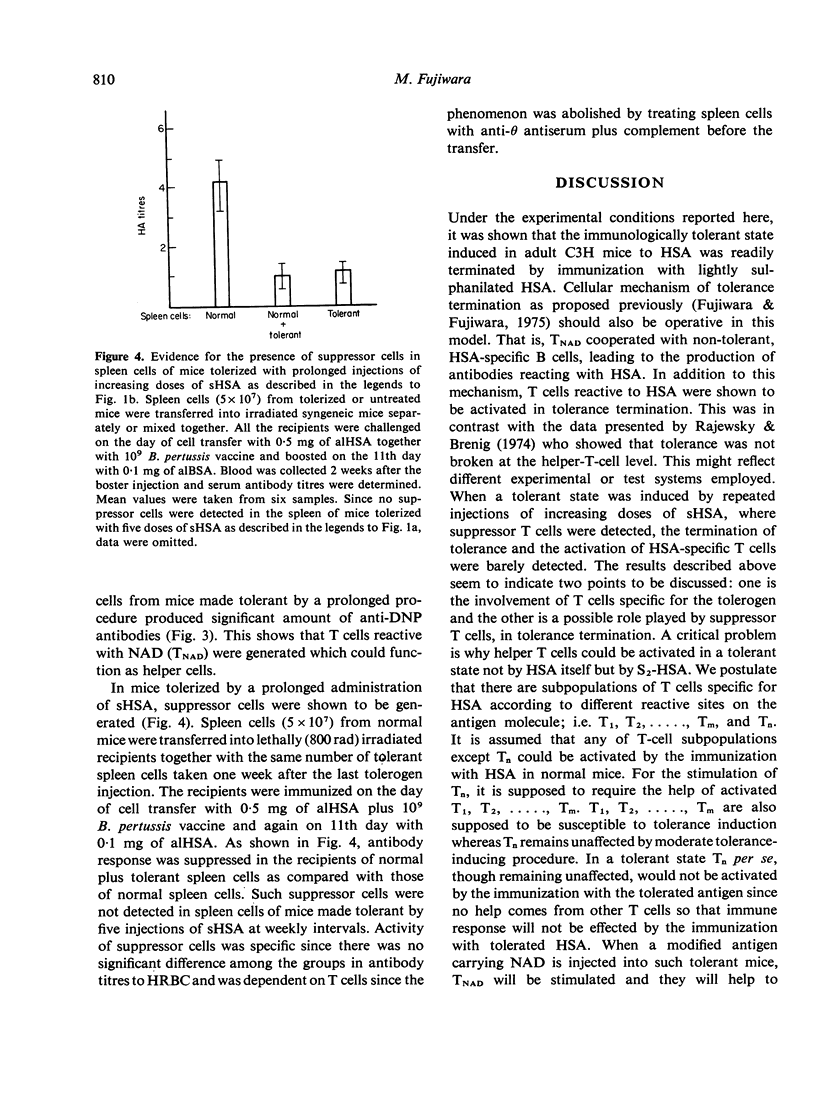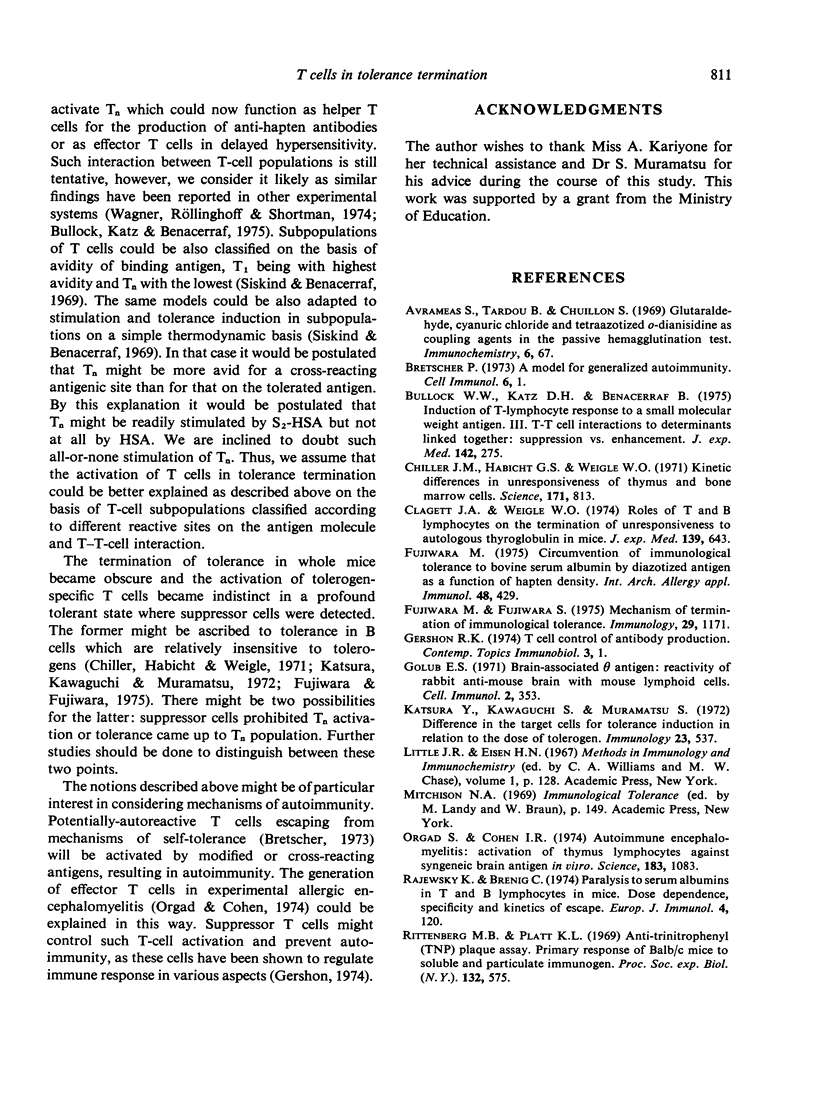Abstract
Immunological tolerance was induced in adult C3H mice by five injections of ultra-centrifuged, soluble HSA at weekly intervals. The tolerant state was readily terminated by the challenge immunization with slightly sulphanilated HSA administered as Freund's complete adjuvant emulsion. In this case, it was shown that T cells specific for HSA were activated which could serve as helpers for the production of anti-hapten antibodies. The tolerance termination and activation of T cells specific for HSA was not observed in the profound tolerant state, induced by nine injections of ultra-centrifuged, soluble HSA at weekly intervals, where suppressor T cells were detected. Implications of these results were discussed in reference to the development of autoimmunity.
Full text
PDF





Selected References
These references are in PubMed. This may not be the complete list of references from this article.
- Bretscher P. Hypothesis: a model for generalised autoimmunity. Cell Immunol. 1973 Jan;6(1):1–11. doi: 10.1016/0008-8749(73)90001-4. [DOI] [PubMed] [Google Scholar]
- Bullock W. W., Katz D. H., Benacerraf B. Induction of T-lymphocyte responses to a small molecular weight antigen. III. T-T cell interactions to determinants linked together: suppression vs. enhancement. J Exp Med. 1975 Aug 1;142(2):275–287. doi: 10.1084/jem.142.2.275. [DOI] [PMC free article] [PubMed] [Google Scholar]
- Chiller J. M., Habicht G. S., Weigle W. O. Kinetic differences in unresponsiveness of thymus and bone marrow cells. Science. 1971 Feb 26;171(3973):813–815. doi: 10.1126/science.171.3973.813. [DOI] [PubMed] [Google Scholar]
- Clagett J. A., Weigle W. O. Roles of T and B lymphocytes in the termination of unresponsiveness to autologous thyroglobulin in mice. J Exp Med. 1974 Mar 1;139(3):643–660. doi: 10.1084/jem.139.3.643. [DOI] [PMC free article] [PubMed] [Google Scholar]
- Fujiwara M. Circumvention of immunological tolerance to bovine serum albumin by diazotized antigen as a function of hapten density. Int Arch Allergy Appl Immunol. 1975;48(3):429–438. doi: 10.1159/000231328. [DOI] [PubMed] [Google Scholar]
- Fujiwara M., Fujiwara S. Mechanism of termination of immunological tolerance. Immunology. 1975 Dec;29(6):1171–1179. [PMC free article] [PubMed] [Google Scholar]
- Gershon R. K. T cell control of antibody production. Contemp Top Immunobiol. 1974;3:1–40. doi: 10.1007/978-1-4684-3045-5_1. [DOI] [PubMed] [Google Scholar]
- Golub E. S. Brain-associated theta antigen: reactivity of rabbit anti-mouse brain with mouse lymphoid cells. Cell Immunol. 1971 Aug;2(4):353–361. doi: 10.1016/0008-8749(71)90070-0. [DOI] [PubMed] [Google Scholar]
- Katsura Y., Kawaguchi S., Muramatsu S. Difference in the target cells for tolerance induction in relation to the dose of tolerogen. Immunology. 1972 Oct;23(4):537–544. [PMC free article] [PubMed] [Google Scholar]
- Orgad S., Cohen I. R. Autoimmune encephalomyelitis: activation of thymus lymphocytes against syngeneic brain antigens in vitro. Science. 1974 Mar 15;183(4129):1083–1085. doi: 10.1126/science.183.4129.1083. [DOI] [PubMed] [Google Scholar]
- Rajewsky K., Brenig C. Paralysis to serum albumins in T and B lymphocytes in mice. Dose dependence, specificity and kinetics of escape. Eur J Immunol. 1974 Feb;4(2):120–125. doi: 10.1002/eji.1830040211. [DOI] [PubMed] [Google Scholar]
- Siskind G. W., Benacerraf B. Cell selection by antigen in the immune response. Adv Immunol. 1969;10:1–50. doi: 10.1016/s0065-2776(08)60414-9. [DOI] [PubMed] [Google Scholar]
- TABACHNICK M., SOBOTKA H. Azoproteins. II. A spectrophotometric study of the coupling of diazotized arsanilic acid with proteins. J Biol Chem. 1960 Apr;235:1051–1054. [PubMed] [Google Scholar]
- Weigle W. O. Immunological unresponsiveness. Adv Immunol. 1973;16:61–122. doi: 10.1016/s0065-2776(08)60296-5. [DOI] [PubMed] [Google Scholar]


